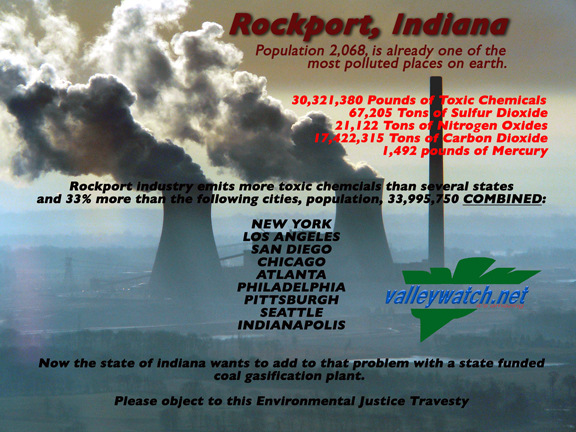April 3, 2012-A Press Release from Environment America (Use this link to download entire report) Editor’s note: Rockport, IN is already one of the most toxic communities in the entire US. And yet, Local and state officials are wanting to force Hoosier natural gas consumers to pay a premium for syngas produced by the proposed Indiana Gasification facility just a mile south of AK Steel and directly across US 231 from the huge polluter AEP’s Rockport power plant, a 2600 megawatt behemoth that supplies electricity to southern Michigan and northeastern Indiana.)

AK Steel built their Rockport plant as a "state of the art" steel mill in 1997 but quickly became the nation's #1 toxic water polluter with routine toxic emission of more than 20 million pounds per year and has remained on top for over a decade since. The plant is just a mile north of the 2600 megawatt Rockport power plant that is one of the nation;s largest polluters in a number of categories as well. Photo © 2011 John Blair
Five states—Indiana, Virginia, Nebraska, Texas, and Georgia—account for forty percent of the total amountof toxic discharges to U.S. waterways in 2010, according to a new report released today by Environment America.Wasting Our Waterways: Industrial Toxic Pollution and the Unfulfilled Promise of the Clean Water Act also reports that 226 million pounds oftoxic chemicals were discharged into 1,400 waterways across the country.
“America’s waterways are a polluter’s paradise right now. Polluters dumped 226 million pounds of toxic chemicals into our lakes, rivers and streams in 2010,” said Shelley Vinyard, Clean Water Advocate with Environment America. “We must turn the tide of toxic pollution by restoring Clean Water Act protections to our waterways.”
The Environment America report documents and analyzes the dangerous levels of pollutants discharged to America’s waters by compiling toxic chemical releases reported to the U.S. EPA’s Toxics Release Inventory for 2010, the most recent data available.
Major findings of the report include:
- Pollution from just five states—Indiana, Virginia, Nebraska, Texas, and Georgia—accounted for nearly forty percent of the total amount of pollution dumped into our waterways in 2010
- Food and beverage manufacturing (slaughterhouses, rendering plants, etc.), primary metals manufacturing, chemical plants, and petroleum refineries were some of the largest polluters. AK Steel dumped the most toxic pollution—nearly 30 million pounds—into our waterways in 2010.
- In 2010, industries discharged approximately 1.5 million pounds of cancer-causing chemicals, like arsenic, chromium, and benzene, into America’s waterways. Nevada’s Burns Creek received the largest volume of carcinogens in 2010, while neighboring Mill Creek placed third.
- Nitrates accounted for nearly 90 percent of the total volume of discharges to waterways reported in 2010. Nitrates are toxic, particularly to infants consuming formula made with nitrate-laden drinking water, who may be susceptible to methemoglobinemia, or “blue baby” syndrome, a disease that reducesthe ability of blood to carry oxygen throughout the body.
 Environment America’sreport summarizes discharges of cancer-causing chemicals, chemicals that persist in the environment, and chemicals with the potential to cause reproductive problems ranging from birth defects to reduced fertility. Among the toxic chemicals discharged by facilities are arsenic, mercury, and benzene. Exposure to these chemicals is linked to cancer, developmental disorders, and reproductive disorders.
Environment America’sreport summarizes discharges of cancer-causing chemicals, chemicals that persist in the environment, and chemicals with the potential to cause reproductive problems ranging from birth defects to reduced fertility. Among the toxic chemicals discharged by facilities are arsenic, mercury, and benzene. Exposure to these chemicals is linked to cancer, developmental disorders, and reproductive disorders.
“The Clean Water Act’s original objective was to clean up all of America’s waterways by 1985—27 years ago,” said Rob Kerth, Analyst for Frontier Group and co-author of the report.“Many people born in 1985 have kids of their own now, yet still millions of pounds of toxic chemicals are being dumped into our waterways.”
In order to curb the toxic pollution threatening waterways like the Chesapeake Bay, the Colorado River and Puget Sound, Environment America recommends the following:
- Pollution Prevention: Industrial facilities should reduce their toxic discharges to waterways by switching from hazardous chemicals to safer alternatives.
- Protect all waters: The Obama administration should finalize guidelines and conduct a rulemaking to clarify that the Clean Water Act applies to all of our waterways – including the 2.5 million miles of streams in and 117 million Americans’ drinking water for which jurisdiction under the Clean Water Act has been called into question as a result of two polluter-driven Supreme Court decisions in the last decade.
- Tough permitting and enforcement: EPA and state agencies should issue permits with tough, numeric limits for each type of toxic pollution discharged, ratchet down those limits over time, and enforce those limits with credible penalties, not just warning letters.
“The bottom line is that America’s waterways shouldn’t be a polluter’s paradise, they should just be paradise. We need clean water now, and we are counting on the federal government to act to protect our health and our environment,” concluded Vinyard.

Sadly, it all comes down to money. When governments and the people, not the industries that control them, are willing to spend money to control, regulate, and tighten up the pollution standards, then we will begin to get clean water and air for the only lives we have and the lives of our children. While money is valued for itself, that won’t happen.
So what exactly is AK Steel discharging in the water?
Wonder why environmentalists are never taking seriously. Why show images of cooling towers emitting water vapor?